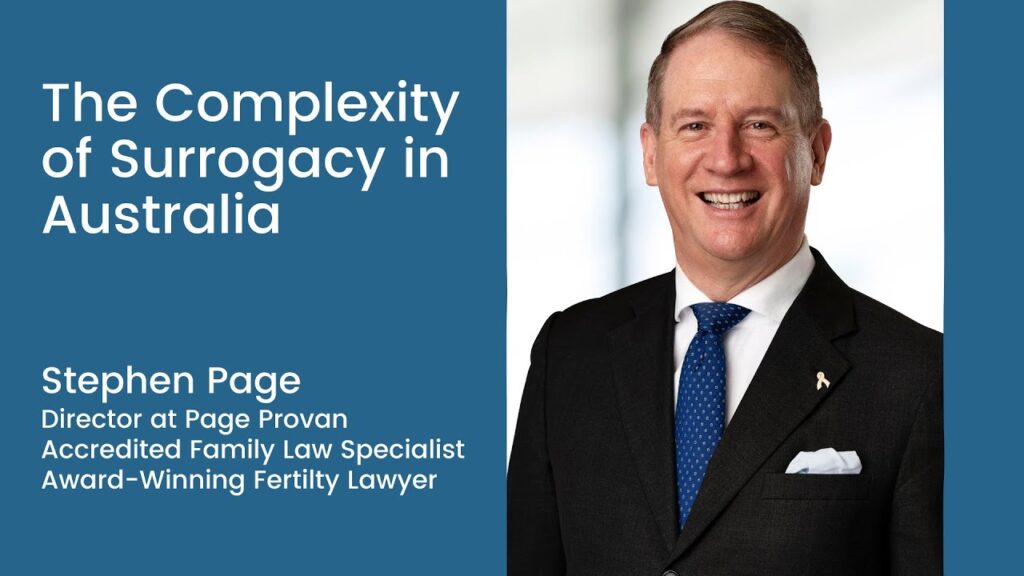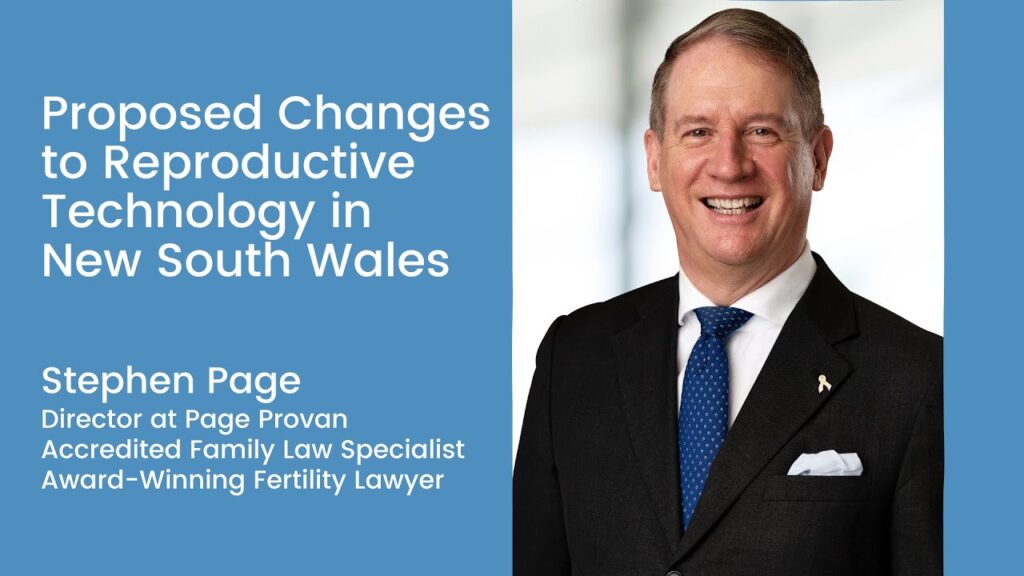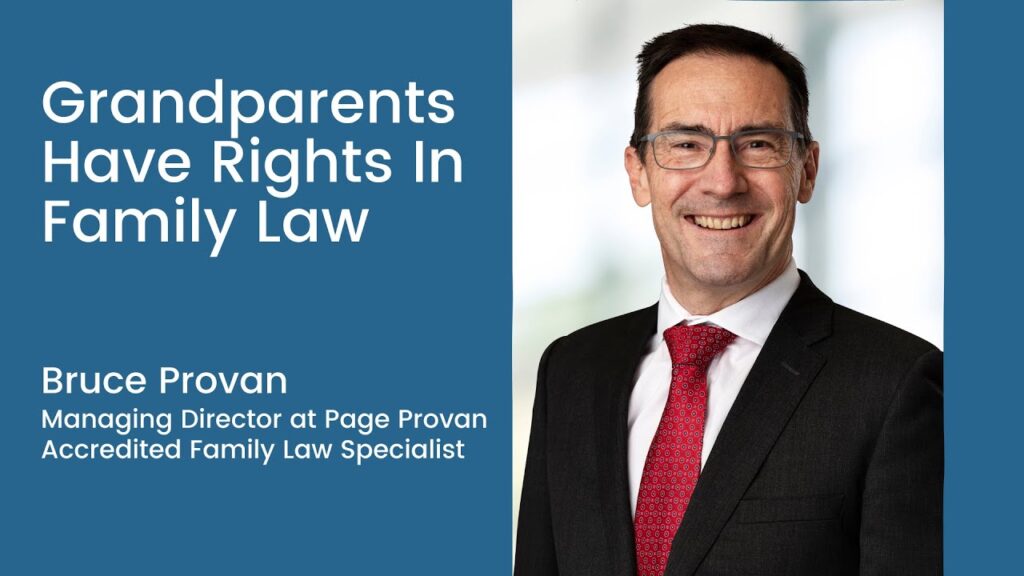The ACT’s Proposed Surrogacy Reforms
In this video, Page Provan Director and award-winning surrogacy lawyer, Stephen Page, discusses what you need to know about the ACT’s proposed surrogacy reforms.
Transcript
G’day, I’m Stephen Page from Page Provan, Family and Fertility Lawyers, and I’m talking about what’s happening in the ACT. By area of size, the ACT is the smallest jurisdiction. If you live in Canberra and you drive 20 minutes that way, you’re in New South Wales. But nevertheless, as we know, several hundred thousand people live there, and the ACT has its own government and it’s now looking at setting up two things. It’s looking at having a central registry, and also looking at having an ART Act. So that then takes me to, well what is a central registry and what is an ART Act, and what’s the significance of all this?
Well, the first thing is that a central registry is a registry run by the state by which gametes donors, so those egg, sperm, or embryo donors, have been recognised and recorded, and why you have a central registry is so that rather than having each clinic having its own registry, which every clinic in Australia is required to do. For donor conceived adults, they don’t play the lottery so much about finding out where they come from, they can just go to the state and inquire of the state.
So I think a central registry is a really good thing. In the ACT currently, there are three IVF clinics, so rather than a donor conceived adult having to go to all three to find out, potentially to find out where they come from, they can go to one, namely the state central registry. Currently, there are central registries in New South Wales, Victoria, and South Australia, and a badly functioning one in Western Australia, hopefully will get better soon.
And there is a proposal well underway in Queensland to have a central registry in Queensland. So I think the idea of an ACT central registry is a good one. I hope, as I said in the submissions to the ACT government, that there’s a one-stop shop approach taken and there hasn’t been to date.
I’ve certainly advocated for that with Queensland, and I hope the ACT does it as well. Namely, just like Google, if you’ve got a donor conceived adult and they say I’ll go to the central registry in the ACT, can you find out where I’ve come from? That the ACT in turn will ask the other central registries, in the absence of a national registry, it would be good to have a national registry, but we don’t.
Ask the other central registries, do you have any records here? And if it doesn’t pop up in the ACT hopefully it pops up in one of the others, and if the ACT and Queensland come on board, then everywhere is covered other than the Northern Territory and Tasmania, and I’ve done a separate video about Queensland.
The ACT seems also to be mindful of having having retrospective transparency. So Victoria is the only place that currently does that in the world. When sperm donors were told all those years ago, secret squirrel business, you’re forever not known to the child, and the parents were told, Don’t tell the child where they’ve come from. Victoria came to the realisation that this was harmful for donor conceived adults.
They didn’t have any say in how they were created, and their process of creation was through secrecy. So leading the way, Victoria set up a central registry and set up having this retrospective transparency. Queensland, as I said, is looking at copying that, as is the ACT. It’s interesting, South Australia looked at doing this, and the view taken by its Parliament was not to have retrospective transparency when it set up its central registry.
It thought on balance that the impact on donors was so great, given the donors were told that they were forever going to be anonymous, that on balance, there shouldn’t be one. But the ACT looks like it’s going the other way. The other issue of more concern to me is that the ACT is talking about having an ART Act, or Assisted Reproductive Treatment Act, or as it’s called in New South Wales, Assisted Reproductive Technology Act.
Namely an act to regulate IVF clinics, and the line that’s been run is, well, there isn’t much regulation of IVF clinics in Australia at the moment. Therefore, there needs to be legislation. If we look at the IVF industry in Australia, you know that that approach is false, that line is false and the reason being that our IVF industry is highly concentrated.
We have five national clinics. It’s five chains, and they are in size verse, which is Melbourne IVF Australia, and that’s what it trades as in the ACT Queensland fertility group, TAS IVF, for example. The second biggest is Monash IVF, which operates in most parts of Australia, but not the ACT. The third biggest is Genea, which is headquartered in Sydney but also operates in Queensland, Victoria, South Australia, Western Australia, Tasmania, and the ACT.
The fourth biggest is City Fertility, which operates in Queensland, New South Wales, Victoria, and Western Australia. And the fifth biggest is a cut price clinic, Adora Fertility, which operates in several states. The point being that these clinics are worth a lot of money, and those who operate these clinics when they operate across state borders make sure they’re compliant. If you have hundreds of millions of dollars of shareholders’ money, you want to make sure that you are compliant.
So I think this concentration in many ways is actually a good thing in terms of compliance issues. The second criteria that stands out to me is that, to be compliant with RTAC accreditation, and to explain the jargon, that’s the Fertility Society of Australia and New Zealand, I’m a board member and it has a committee, the Reproductive Technology Accreditation Committee, or RTAC, I’m not a member of that committee.
RTAC accreditation is required to operate any IVF clinic in Australia. There is a quality scheme that must be complied with, sitting on top of that quality scheme is the code of practice, the RTAC Code of Practice, which incorporates ethical guidelines issued by the National Health and Medical Research Council.
And their full name, sorry for the mouthful, is Ethical Guidelines on the use of Assisted Reproductive Technology in Clinical Practice and Research, and the latest version is 2023. Taken all together, clinics must comply with these. They must be accredited and if they’re not accredited, they fail and they are either compliant or non compliant, so the idea that there needs to be further regulation of IVF clinics, I think is a false one. In the feedback that we’ve seen given to the ACT government, two standouts from consumers were really there.
One was cost, now, the more regulation you impose on IVF clinics on top of what they’ve already got, guess what? Cost goes up, and if you’re incurring more cost as an IVF clinic, what do you do? Well, you don’t absorb that cost. Ultimately, you charge it onto the consumer. So further regulation means extra cost, I just think that is just so obvious, it’s as certain as night follows day. The second one is, well, there’s going to be greater difficulty for LGBTQIA+ people in the ACT, in accessing sperm. So if you’re a single woman or a lesbian couple, for example, and you need to access sperm, it’s difficult.
Choices are limited, but guess what? The proposed model the ACT government is looking at is to replicate the New South Wales Assisted Reproductive Technology Act and in one sense, that makes sense. The ACT is an island sitting in the middle of New South Wales, you have the same as New South Wales Act, it makes it simple. Except that’s really, really dumb and why it’s dumb is because New South Wales, there’s two three reasons that stand out. The first is that the New South Wales ART Act has a limit of five women who are recipients for any donor.
There’s a cap, and that five women cap which includes a partner of the original recipient woman, is really four because it excludes the donor’s own family, and that cap is half that we see in Victoria, South Australia, Northern Territory, Tasmania, Queensland, and the ACT currently. So what that change will do, will mean it’s actually harder for same sex couples or single women accessing sperm in the ACT than it is now and it’ll have the other effect that if they don’t have access to their sperm, they’ve got to go elsewhere, which means their costs go up.
So it actually hits both those nails on the head the wrong way. The other change that would come if there’s replication of the New South Wales Act is in effect to prevent posthumous use of sperm in the ACT. Because the New South Wales Act says, yeah, sure, you can use posthumous use of a sperm, but the gamete provider, namely the deceased, must have consented to that before he died. Well, what happens when he dies suddenly, unexpectedly? Falling off a skateboard, having had an accidental drug overdose, having had a stroke, any of these things I’ve seen this happen, commit suicide, any of those.
Well, in Queensland you can use ACT you can use, at the moment, but you can’t in New South Wales and we’ve had case law from Western Australia, South Australia, New South Wales, where the grieving widows have been able to export their sperm to guess where? The ACT. If the ACT copies the New South Wales laws, they won’t be able to do it anymore. Instead, they’ll have to come to Queensland. So let’s see if they do that, and the third aspect is one of those issues that says, why should there be a regulator?
Because the central registry in New South Wales talks about, well, gamete providers who are donors need to be recorded with the central registry, and the intent of parents through surrogacy also have to be recorded. But the New South Wales Ministry of Health has taken the view that if you are a gamete provider and you’ve provided your sperm or your egg to enable a surrogate to become a legal parent, to then give birth to that child and hand over the child to you, you’re a donor to that surrogate.
So they’re saying that you’re a donor of your own child. Now, I’ve made representations to the New South Wales Department, their position is unchanged, it’s unmovable. I think that that position is thoroughly disrespectful of intended parents and also that of the autonomy of the surrogates and the surrogate’s partners. But if the ACT copies those laws, that’s what it will achieve in the ACT as well. So let’s see, it’s a watch this space, we’ll see what the ACT government comes up with, and I’ll talk about it in another video or videos.
Thank you.












